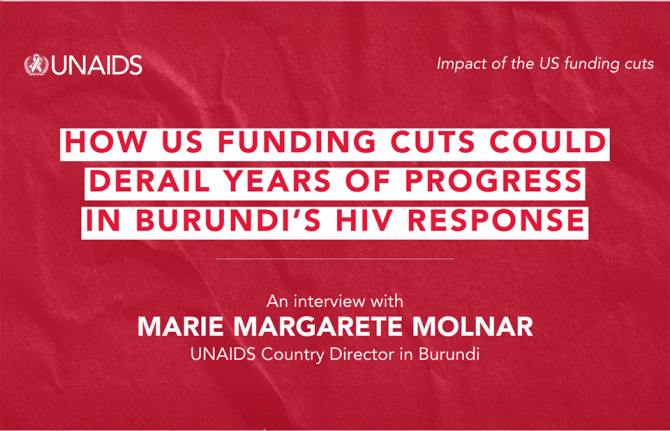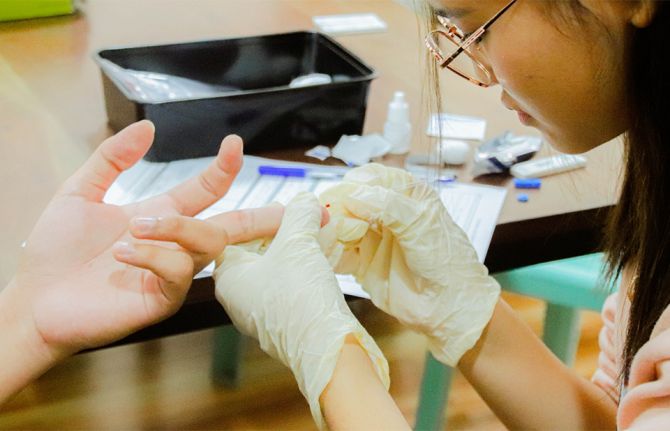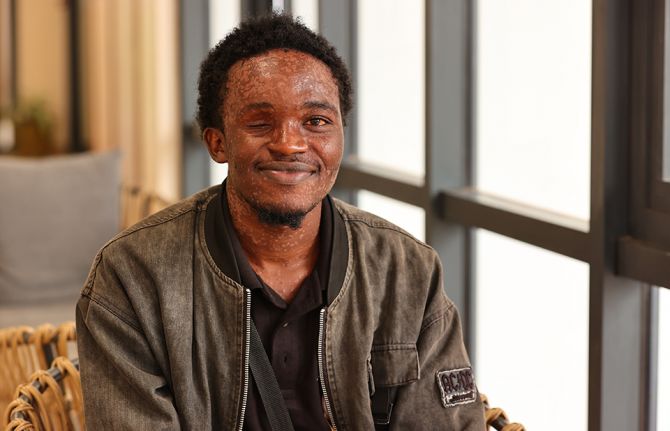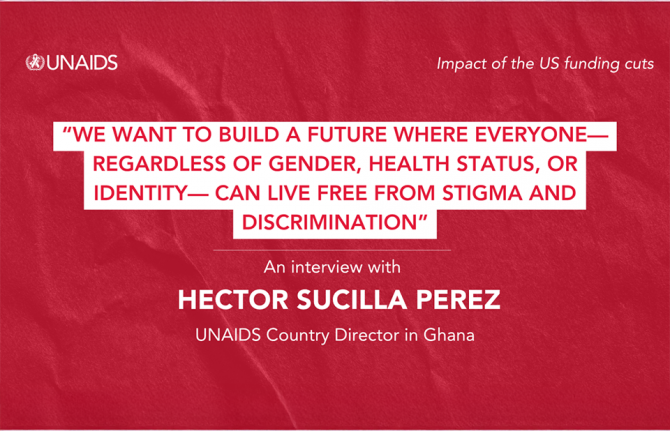

Feature Story
How US funding cuts could derail years of progress in Burundi’s HIV response
14 May 2025
14 May 2025 14 May 2025Q&A with UNAIDS Country Director in Burundi
International aid is shrinking, and countries are increasingly burdened by the need to prioritize debt repayment over essential services, including healthcare. This shift has left vulnerable populations more exposed, with the abrupt funding cuts by the United States throwing the HIV response in many countries into chaos. Burundi, unfortunately, is no exception. Across the country, HIV services have faced severe disruptions. Clinics are reducing their services, staff are being laid off, and thousands of people living with HIV are at risk of losing access to critical treatment.
In this interview, Marie Margarete Molnar, UNAIDS Country Director in Burundi, explains how communities are being affected, how the health system is coping, and what must happen next.
Q: Can you describe the current funding landscape for Burundi’s HIV response?
Burundi’s HIV response relies heavily on international aid - 95% of its funding comes from donors, with the US government contributing 51% through PEPFAR. This support sustained 10 major projects covering HIV prevention, treatment, and care for both the general population and vulnerable populations. PEPFAR also provided support to community-led monitoring projects and critical data system information.
Q: How have the recent US funding cuts affected these programmes?
Out of the 10 PEPFAR-funded projects, three were not eligible for the US waiver and had to stop operating. Some of the remaining seven, although eligible, could not resume their activities due to delays and financial uncertainty. As a result and based on an assessment conducted during the first month of the pause, at least 10 000 people living with HIV—who were among the 79 000 currently under treatment—have been directly affected. These individuals risk losing consistent access to medication and support services. In addition, 167 health professionals have lost their positions. These include doctors, nurses, psychologists, lab technicians, and community health workers—many of whom were directly providing HIV services. Financially, the immediate PEPFAR cut represents approximately US$ 6.5 million from the annual PEPFAR envelope of US$ 25 million for HIV in Burundi.
Q: What does this mean in practical terms for people on the ground?
Burundi had almost reached the 2025 ambitious targets: 95% of people living with HIV who know their HIV status, of whom 95% are on treatment and of the people on treatment 95% are virally suppressed. This was the result of strong collaboration between the government, civil society organizations and partners. The country was even recognized with an award. But now the third 95, on viral suppression, is declining because some people can no longer access viral load testing or follow-up services. If the situation continues, there is a high risk of an increase in new infections and a weakening of the entire HIV response system.
Q: What steps have the government and partners taken so far to respond to the crisis?
The government and partners acted quickly. UNAIDS conducted consultations during the first two weeks of February with key stakeholders. These consultations identified the scale of the impact and led to a series of recommendations that were shared with the Government and partners. The Ministry of Health together with UNAIDS and WHO held a two-day workshop with the PEPFAR implementing partners and civil society to understand how the cuts affected budgets, staffing, services, and beneficiaries and to brainstorm on rapid mitigation measures. As instances, it was recommended carrying out field missions to visit treatment sites and assess how services were coping without US support, forming a crisis response group and developing a national contingency plan. The government also began to identify treatment sites facing ARV shortages and organized a drug quantification workshop after PEPFAR-supported partners could no longer lead it.
Finalizing the HIV Sustainability Roadmap has also become a top priority. The roadmap is intended to guide how Burundi can finance and manage its HIV response without relying so heavily on external donors. We also discussed modeling different scenarios, from best case to worst case, based on whether funding returns or disappears entirely. These models would help us plan, reprioritize, and adapt strategies accordingly. We are also using the UNAIDS Rapid AIDS Financing Tool (RAFT) to get detailed data on how the funding cut is affecting commodities and staffing across the country.
Q: Is the government prepared to increase its contribution to its national HIV efforts?
It’s trying. Previously, funding for antiretroviral treatment was split between 76% from the Global Fund, 15% from the government, and 9% from PEPFAR. The government has now committed to covering partially that missing 9%. That shows political will. But it’s not just about medicine. It’s about health workers, community programmes and lab capacity. Burundi will need to restructure its approach by, for instance, integrating HIV into broader health and social protection systems, and significantly increase domestic health funding to reduce dependency, but this is difficult given the country's economic constraints.
Q: What’s your message to the international community?
Burundi is a fragile country facing multiple crises—economic instability, fuel shortages, emerging epidemics, and an influx of refugees from neighboring Democratic Republic of Congo. Despite these challenges, the country has made significant progress towards ending HIV, thanks to sustained investment in health including the HIV response. The risk now is losing these gains. Continued support from international partners is essential, not just for health but for the country’s overall development. At the same time, the Burundian government must increase its commitment to health funding. Only through global solidarity and strong political will can Burundi hope to end HIV by 2030.
The global community must understand that this is more than a budget line. It’s about lives, stability and global health security.
The Joint United Nations Programme on HIV/AIDS (UNAIDS) leads the global effort to end AIDS as a public health threat by 2030 as part of the Sustainable Development Goals.
Following the US stop work order in January, UNAIDS is working closely with governments and partners in affected countries to ensure that all people living with or affected by HIV continue to access life-saving services. For the latest updates, please visit unaids.org



